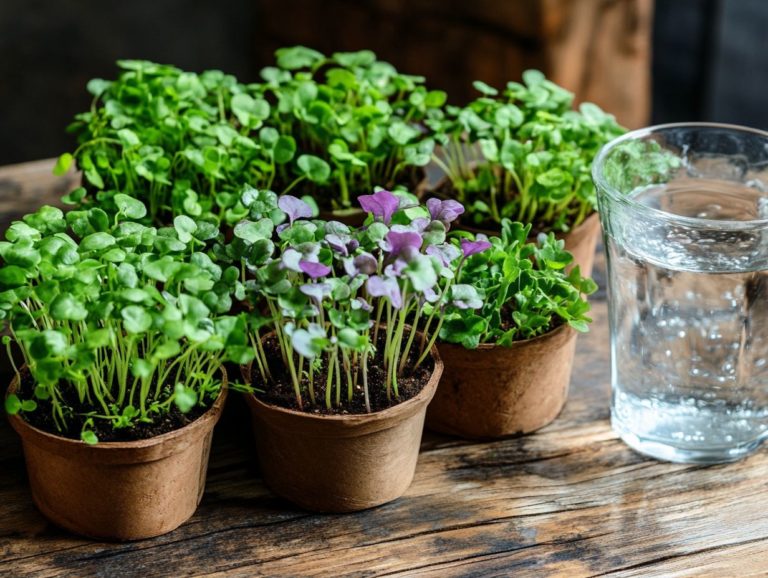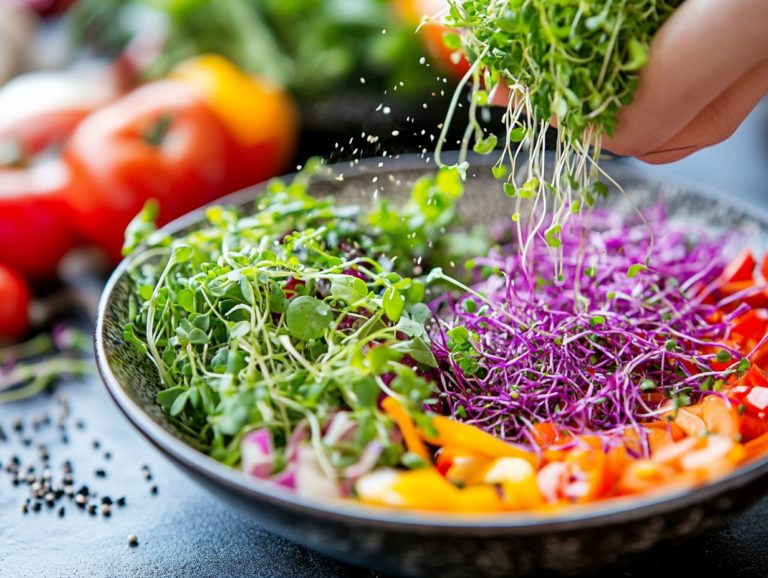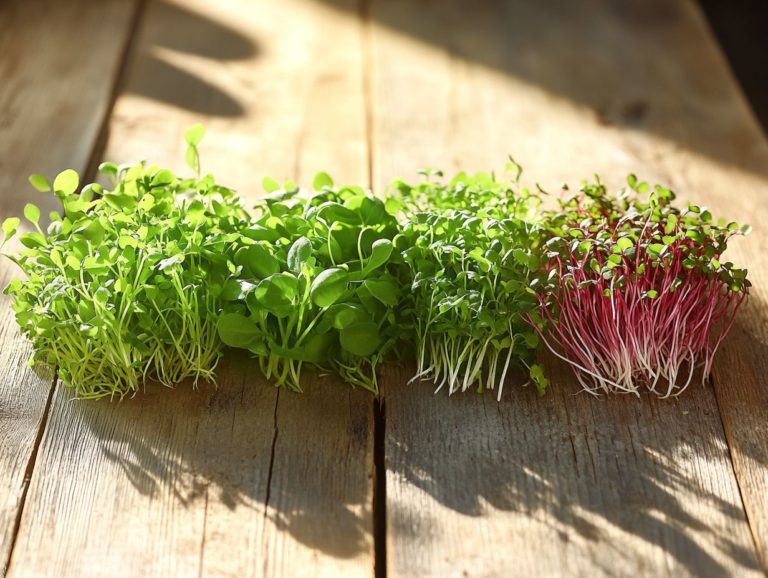7 Microgreens Packed with Vitamins
Microgreens are not just tiny plants; they are powerful nutritional boosters you need in your meals! They are flavorful powerhouses brimming with nutrients, making them a go-to for health enthusiasts like yourself.
Consider exploring seven remarkable varieties, including arugula, broccoli, kale, mustard, radish, red cabbage, and more:
- Broccoli: Packed with vitamins and great for immune support.
- Kale: A superfood rich in essential nutrients.
- Red Cabbage: Contains antioxidants and supports overall health.
- Sunflower: Offers beneficial oils and nutrients.
- Pea Shoot: Great source of vitamins and minerals.
- Radish: Known for its peppery flavor and health benefits.
- Cilantro: Adds freshness and is rich in vitamins.
These miniature greens are hailed as superfoods thanks to their impressive nutritional benefits and their effortless integration into your meals. You can also find handy tips for growing them right at home.
Be aware of potential risks when consuming microgreens. Explore microgreens today and discover the amazing benefits they can bring to your health!
Contents
- Key Takeaways:
- 1. Broccoli Microgreens
- 2. Kale Microgreens
- 3. Red Cabbage Microgreens
- 4. Sunflower Microgreens
- 5. Pea Shoot Microgreens
- 6. Radish Microgreens
- 7. Cilantro Microgreens
- Why Are Microgreens Considered Superfoods?
- Frequently Asked Questions
- What are microgreens?
- Why are microgreens considered to be packed with vitamins?
- What are the top 7 microgreens that are packed with vitamins?
- How do these microgreens provide vitamins to our bodies?
- What are the benefits of consuming microgreens packed with vitamins?
- Are there any specific ways to include microgreens packed with vitamins in our diet?
Key Takeaways:
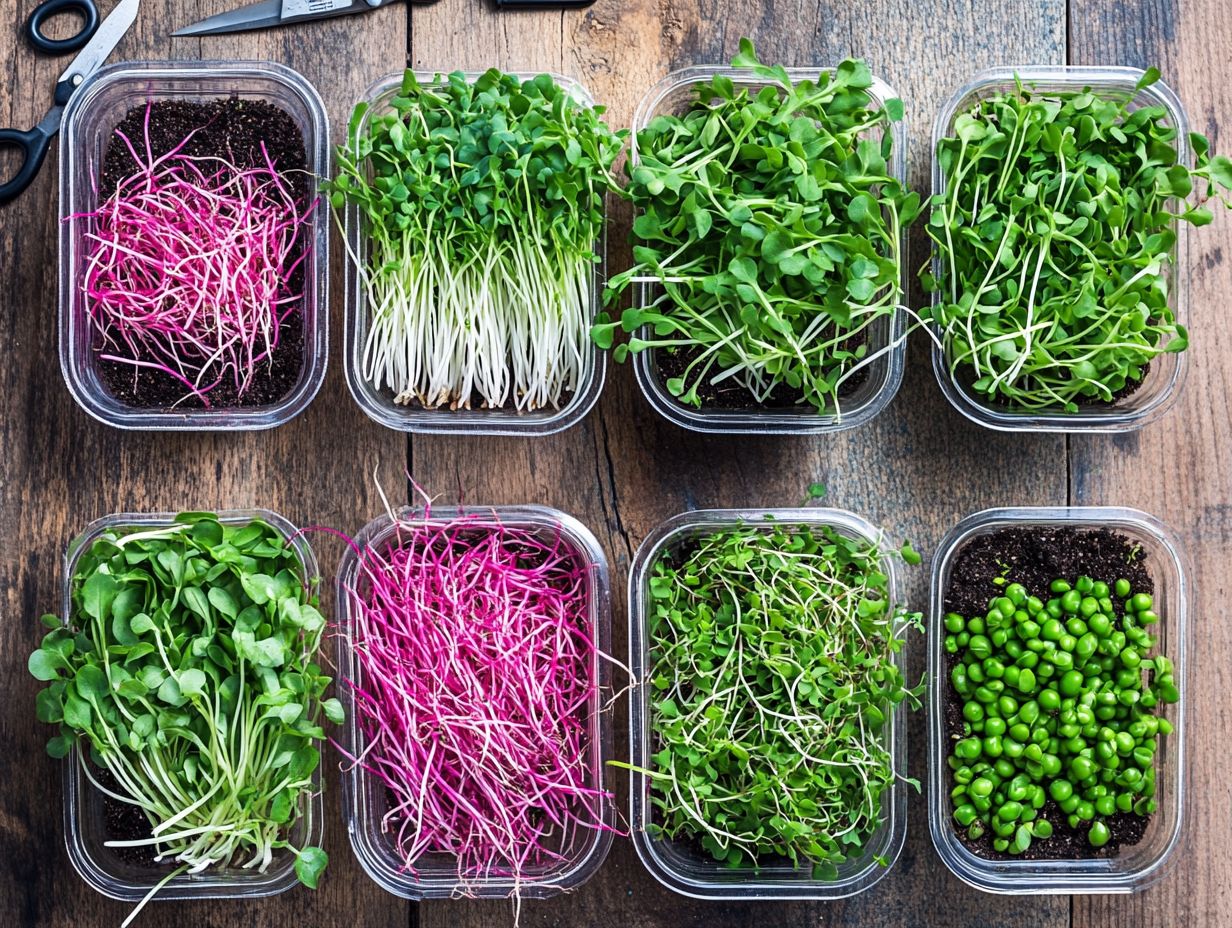
- Broccoli, kale, and red cabbage microgreens are packed with vitamins A, C, and K, making them excellent sources of antioxidants and anti-inflammatory compounds, which are vital for preventing conditions like Chronic Kidney Disease.
- Sunflower, pea shoot, and radish microgreens are high in B vitamins, including vitamin B8, which support energy production and overall health.
- Cilantro microgreens are a good source of vitamin E, essential for hair, skin, and eye health. They can be easily grown at home for a cost-effective and nutrient-rich addition to any diet.
1. Broccoli Microgreens
Broccoli microgreens are packed with nutrients. They offer a concentrated source of vitamins C and K. These powerful antioxidants make them an excellent choice for anyone looking to enhance their immune system, boost energy levels, and support cellular health in their diet, promoting bone health and overall vitality.
In addition to these vitamins, they also provide noteworthy amounts of calcium and iron, both essential for maintaining bone health and facilitating oxygen transport in the blood. According to nutritional analysis data from Eurofins Scientific, just 100 grams of these microgreens can yield over 100 mg of calcium and around 1.2 mg of iron.
Incorporating broccoli microgreens into your meals is easy; toss them into salads, sandwiches, or smoothies, effortlessly enhancing both the nutritional value and flavor of your dishes. With their vibrant taste and impressive health benefits, these tiny greens can easily become a cherished staple in your balanced and nutritious diet.
2. Kale Microgreens
Kale microgreens truly shine as a superfood, brimming with essential nutrients like high levels of vitamin K1, folate, and powerful antioxidants. These nutrients work together to elevate your overall health and wellness.
These petite greens also offer substantial benefits for your brain, supporting cognitive function and potentially reducing the risk of neurodegenerative diseases. Their abundant vitamin K content is vital for maintaining strong bones and healthy joints, making them an ideal choice for anyone focused on joint care, particularly for those dealing with Alzheimer s disease.
Incorporating kale microgreens into your daily meals is easy; toss them into salads for an added crunch, blend them into smoothies for a nutritional boost, or sprinkle them atop soups and sandwiches to enhance both flavor and health benefits.
3. Red Cabbage Microgreens
Red cabbage microgreens present a vibrant and nutrient-dense option. They are brimming with antioxidants and plant compounds that can improve health that bolster your immune system and promote overall health.
These petite greens are particularly abundant in vitamin C, a vital nutrient for maintaining skin health and enhancing iron absorption. Beyond their impressive nutritional profile, they bring a subtly peppery flavor that can elevate an array of dishes and contribute to a healthier lifestyle.
Whether you sprinkle them atop a fresh salad, blend them into smoothies for an extra health boost, or use them as a garnish for soups and sandwiches, red cabbage microgreens not only enhance the visual appeal of your meals but also offer a wealth of beneficial compounds that support your well-being.
4. Sunflower Microgreens
Sunflower microgreens are a delightful enhancement to your healthy diet, offering a rich source of energy and essential nutrients like vitamin E and magnesium, which are vital for maintaining optimal bodily functions.
These youthful greens provide a burst of vitality. They support your cellular health by combating oxidative stress, which can harm your cells, and reducing inflammation in your body.
If you’re looking to elevate your meals, incorporating these microgreens is easy simply toss them into salads, blend them into smoothies, or layer them on sandwiches to add texture and flavor.
Growing your own sunflower microgreens at home is a breeze; all you need are some organic seeds, quality potting soil, and a bit of light. In just a few days, with minimal care, you can savor the fresh, nutty taste and numerous health benefits that come from this vibrant addition to your kitchen.
5. Pea Shoot Microgreens
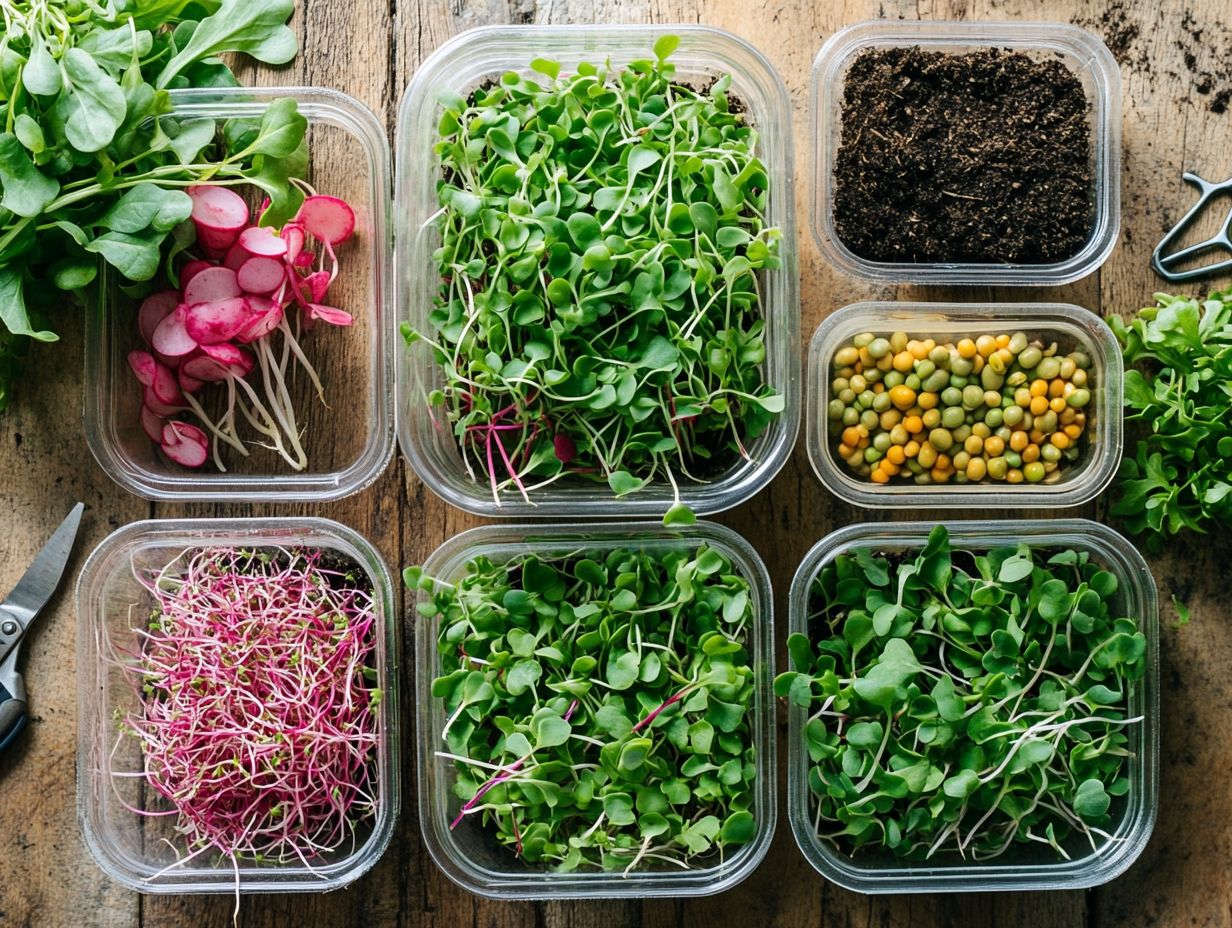
Pea shoot microgreens bring a refreshing flavor to your palate and are bursting with vitamins, including choline, which supports brain health and contributes to a balanced, nutritious diet.
These vibrant greens are not just a feast for the eyes; they deliver a powerful nutritional punch with vitamins A, C, and K, essential for your overall wellness. Their tender leaves introduce a crisp texture and delicate sweetness to a variety of dishes, making them a perfect choice when considering the nutritional benefits of common microgreens.
Incorporating them into your meals is a breeze simply toss them into a fresh salad for that extra crunch, layer them between slices of whole grain bread for a wholesome sandwich, or blend them into smoothies for a subtle flavor enhancement.
Exploring the versatility of pea shoot microgreens can elevate your culinary creations while providing significant health benefits. Start growing your own today and embrace the freshness in your meals!
6. Radish Microgreens
Radish microgreens are not only visually stunning; they pack an exciting spicy punch and are brimming with antioxidants that bolster your immune system and promote overall wellness.
These petite greens are loaded with essential nutrients, particularly potassium, which is vital for maintaining healthy blood pressure and ensuring proper muscle function. They also contain an impressive array of vitamins A, C, and K, all of which contribute to glowing skin and enhanced immunity.
Their peppery flavor makes them a stellar addition to salads, sandwiches, and wraps, or even as a vibrant garnish for soups and grilled dishes.
If you re aiming to elevate your culinary creations, consider tossing a handful of radish microgreens into a stir-fry or omelet. They ll introduce a delightful crunch and zesty flavor, transforming even the simplest recipes into something extraordinary, especially when using fresh ingredients from urban gardening techniques.
7. Cilantro Microgreens
Cilantro microgreens elevate your meals with a burst of fresh flavor and are packed with essential nutrients. Packed with antioxidants, they contribute significantly to a healthy diet and overall wellness.
These tiny greens are a treasure trove of vitamins A, C, and K, along with essential minerals like potassium and magnesium, making them a true powerhouse of nutrition.
Their vibrant, zesty taste not only enhances the visual appeal of your dishes but also pairs beautifully with a range of cuisines, from Mexican to Asian. You can seamlessly incorporate them into salads, smoothies, or use them as a striking garnish on tacos or soups.
To fully reap the benefits of their rich nutrient profile, it s best to add cilantro microgreens toward the end of cooking. This preserves their delicate flavor and maximizes their health-promoting properties, allowing you to enjoy both taste and nutrition in every bite.
Why Are Microgreens Considered Superfoods?
Microgreens are celebrated as superfoods. They provide impressive nutrients.
These petite greens pack a powerful punch. They offer high levels of vitamins C, E, K, and vital plant compounds that can benefit your health.
Their rich nutrients boost energy levels. They are a natural choice to sustain your vitality.
These greens also support cellular health. They help regenerate cells and promote vitality.
What Are the Nutritional Benefits of Microgreens?
The nutritional benefits of microgreens are remarkable. They contain elevated levels of vitamins, minerals, and antioxidants that support immune function, cellular vitality, and promote healthy hair and skin.
These small yet powerful plants are harvested right after their first true leaves emerge. They deliver a substantial nutritional punch. Research from Eurofins Scientific reveals that microgreens can contain up to six times more vitamin C than their mature counterparts, making them a part of the top 10 microgreens for nutritional boost.
Studies from BioTeSys indicate that certain varieties, such as kale and mustard greens, are exceptionally rich in calcium and iron. This makes them superb options for boosting your intake of these essential minerals. Adding microgreen varieties and their health benefits to your meals greatly enhances your overall health, providing a simple and enjoyable way to meet your daily nutritional goals.
How Can Microgreens Be Incorporated into a Diet?
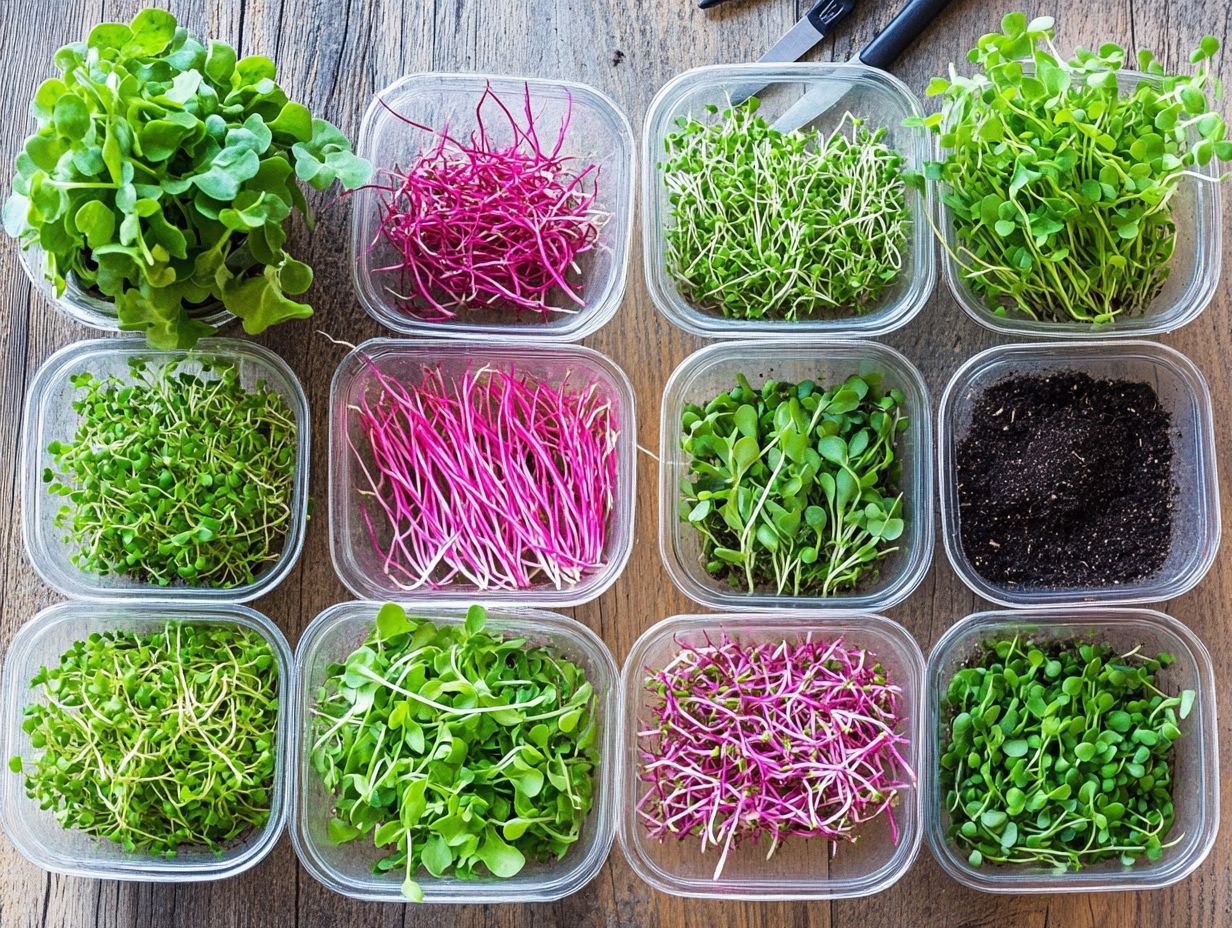
Adding microgreens to your meals is easy and fun! These tiny greens bring vibrant flavor, color, and nutritional value to various dishes, boosting your energy and overall health.
You can easily sprinkle them on salads for a refreshing burst of nutrients that conventional greens often lack. For sandwiches, they serve as a flavorful substitute for traditional lettuce, adding both crunch and a zesty kick.
When blended into smoothies, microgreens deliver a powerful punch of vitamins while keeping that smooth texture you love. Their diverse flavors not only elevate your meals but also inspire a creative cooking experience, making healthy eating enjoyable and accessible. For those looking to maximize health benefits, exploring the best microgreens for nutritional value can be a great addition to your diet.
What Are the Different Types of Microgreens?
You ll find a delightful array of microgreens, featuring popular varieties like arugula, broccoli, kale, mustard, radish, and red cabbage. Each boasts distinct flavors and health benefits that elevate your culinary creations.
- For instance, arugula offers a peppery punch, making it excellent for salads or as a garnish on pizzas.
- Broccoli microgreens present a slightly nutty taste, perfect for enriching smoothies or enhancing sandwich toppings.
- Kale microgreens are tender and mild, adding a lovely touch to stir-fries, while mustard microgreens introduce a spicy kick to tacos or wraps.
- Radish microgreens deliver a sharp, zesty flavor, ideal for giving any dish a flavorful boost. Red cabbage microgreens bring a splash of color and crunch to your plate.
Growing these greens is a breeze; they thrive indoors on a sunny windowsill or in small containers, making them accessible for any home cook eager to impress. For more insights on their benefits, check out microgreens: nature’s vitamins in a tiny package.
Add these tasty microgreens to your meals today! You ll enhance the flavors and elevate the nutritional content of your dishes.
How Can One Grow Microgreens at Home?
Growing microgreens at home is an accessible and rewarding task, whether you choose hydroponics or traditional soil methods. It offers a fresh supply of nutrient-dense greens that can elevate your healthy diet.
To embark on this journey, gather a few essential materials: seeds, a growing tray, potting soil, and a light source if you re cultivating indoors. Start by selecting your preferred microgreen seeds options range from peppery arugula to nutty sunflower.
The ideal growing environment is warm and well-lit. Aim for a temperature range of 60-70 F to help these greens flourish.
For those just starting out, it s vital to keep moist soil without making it soggy. Proper drainage is key to preventing rot. Dive into urban gardening and enjoy the thrill of growing your own food! This practice not only boosts your self-sufficiency but also deepens your connection to the natural world, fostering a sense of accomplishment and well-being as you cultivate your own food.
What Are the Potential Risks of Consuming Microgreens?
While microgreens are generally a safe and nutritious choice, there are some potential risks to consider, particularly regarding food safety and proper handling.
Keep in mind that the small size and delicate nature of these greens make them especially vulnerable to contamination from pathogens. This can happen during harvesting, packaging, or even in your kitchen. That’s why it’s essential to source these vibrant greens from reputable suppliers who uphold strict hygiene standards.
Never underestimate the importance of proper washing techniques. Gently rinsing microgreens under running water can effectively remove surface contaminants.
By taking these precautions, you can fully savor the rich flavors and health benefits that microgreens provide while minimizing any potential risks. Enjoy the journey of incorporating these little powerhouses into your meals!
Frequently Asked Questions
What are microgreens?
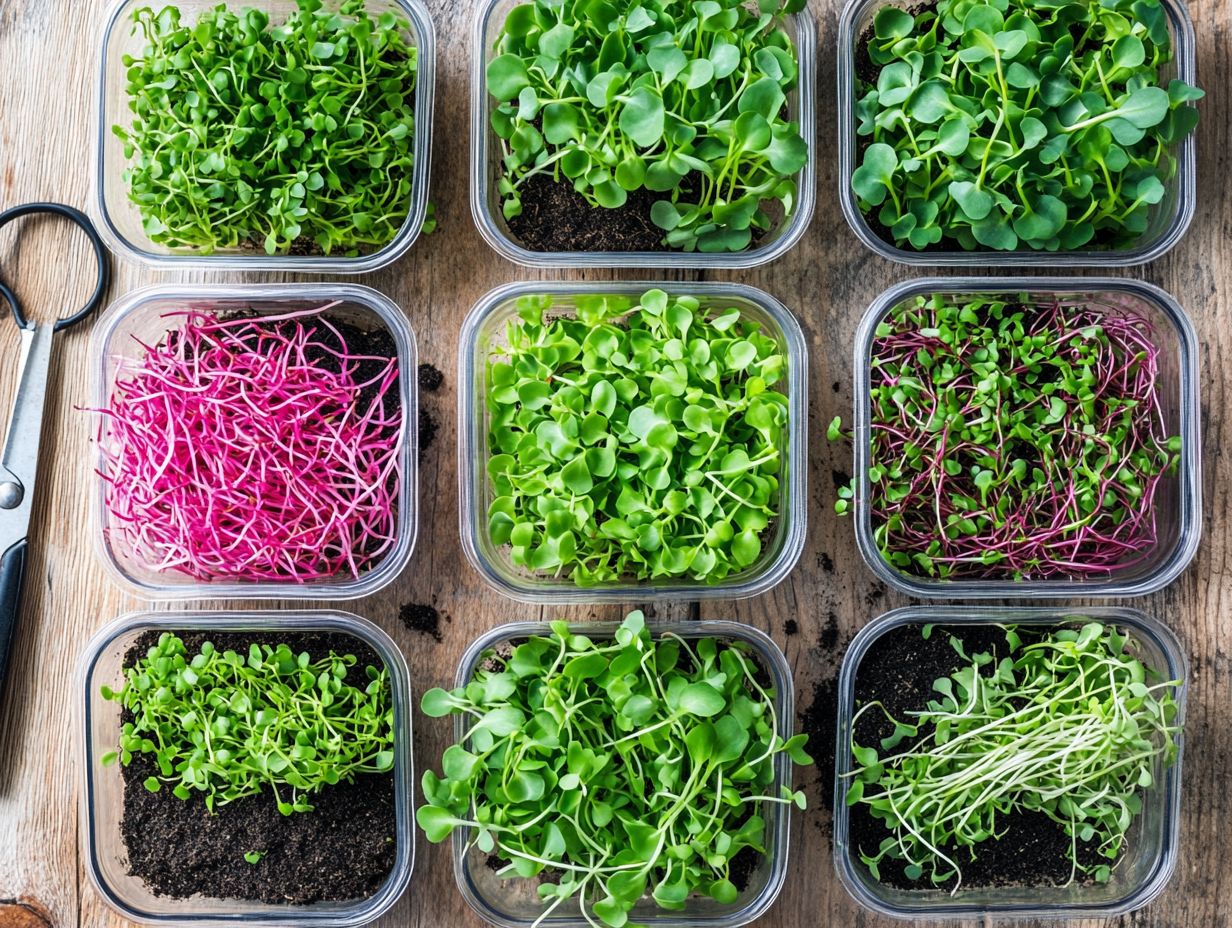
Microgreens are young, edible greens that are harvested after the sprouting stage and before the plant becomes a mature vegetable.
Why are microgreens considered to be packed with vitamins?
Microgreens are packed with vitamins because their small size allows them to concentrate higher levels of nutrients compared to their fully grown counterparts.
What are the top 7 microgreens that are packed with vitamins?
- Broccoli
- Kale
- Beet
- Sunflower
- Pea
- Radish
- Cilantro
How do these microgreens provide vitamins to our bodies?
When we consume microgreens, we are taking in the concentrated nutrients and vitamins that the greens have absorbed during their early growth stage.
What are the benefits of consuming microgreens packed with vitamins?
Consuming microgreens packed with vitamins can improve our overall health and well-being, boost our immune system, and provide us with essential vitamins and minerals.
Are there any specific ways to include microgreens packed with vitamins in our diet?
Yes! Microgreens can be added to salads, sandwiches, wraps, smoothies, and even as a garnish on top of dishes to add a nutritious boost to our meals.
Start your microgreens journey today and transform your meals!



